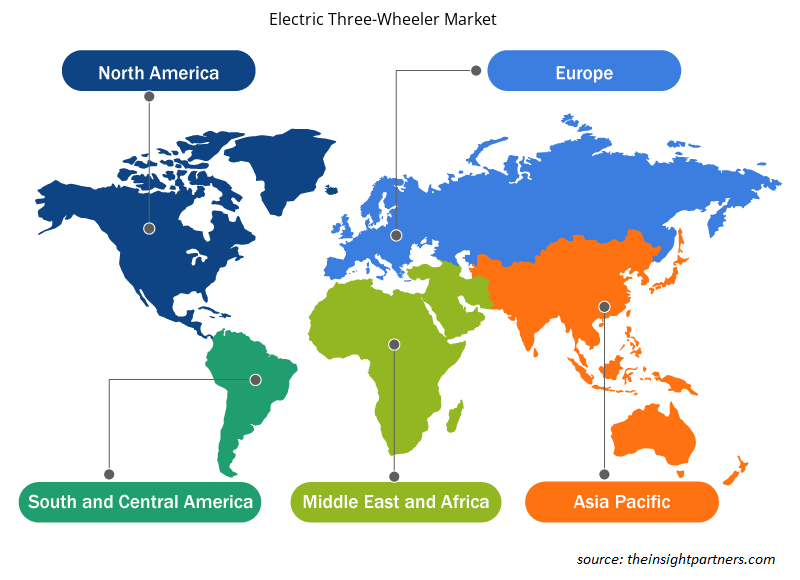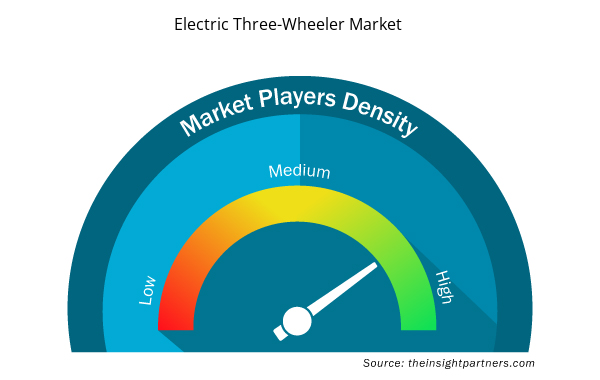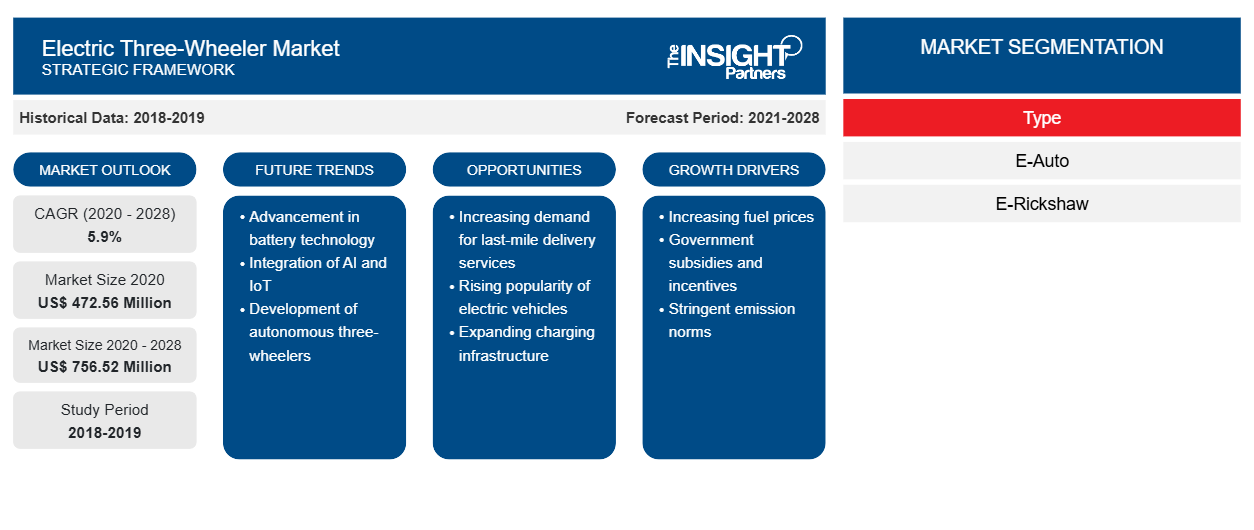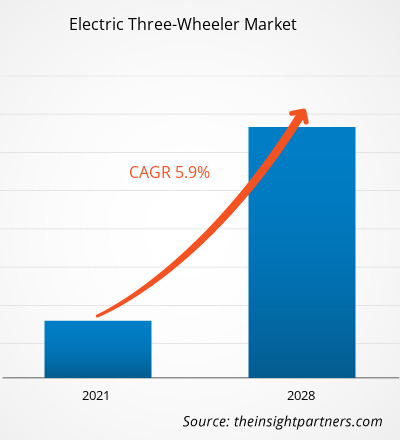El mercado de vehículos eléctricos de tres ruedas se valoró en 472,56 millones de dólares en 2020 y se proyecta que alcance los 756,52 millones de dólares en 2028; se espera que crezca a una CAGR del 5,9% entre 2021 y 2028.
Los vehículos eléctricos de tres ruedas se utilizan ampliamente para transportar pasajeros a su destino deseado, así como para el transporte de mercancías. Estos vehículos de tres ruedas funcionan con motores eléctricos alimentados por baterías recargables. Las baterías se pueden recargar en una estación de carga eléctrica o en cualquier otro punto de carga correspondiente. Muchos países de ingresos bajos y medios en todo el mundo tienen una mayor tasa de uso de vehículos de tres ruedas, que inicialmente estaban propulsados por motores de combustión interna (IC). Pero la mayoría de estos vehículos de tres ruedas con motor de combustión interna se han vuelto ineficientes y obsoletos. Esto ha llevado a los fabricantes a aumentar su gasto en investigación y desarrollo de vehículos eléctricos de tres ruedas. Además, los vehículos eléctricos de tres ruedas son muy populares en las áreas urbanas y suburbanas, especialmente para transportar una pequeña cantidad de pasajeros y mercancías compactas en un corto período de tiempo. Algunos de los factores clave que impulsan el crecimiento del mercado de vehículos eléctricos de tres ruedas son las estrictas normas y regulaciones gubernamentales con respecto al control de la contaminación, la creciente conciencia sobre los efectos nocivos de las emisiones de los vehículos diésel y la gasolina, y la creciente aceptación de los vehículos eléctricos. Dado que la gasolina y el diésel son recursos agotables, la gente ya ha comenzado a pensar en otras posibles alternativas. Los vehículos eléctricos de tres ruedas han comenzado a reemplazar a los vehículos de gasolina y diésel. El costo promedio de mantenimiento y operación de los vehículos eléctricos de tres ruedas es sustancialmente menor que el de los vehículos convencionales de tres ruedas. Sin embargo, el paquete de baterías pesado y la baja autonomía son algunas de las áreas que preocupan a los fabricantes de vehículos eléctricos de tres ruedas. Los vehículos eléctricos de tres ruedas recorren aproximadamente entre 125 y 130 km con la batería completamente cargada, mientras que los vehículos convencionales recorren aproximadamente entre 200 y 220 km con el tanque de combustible lleno.
APAC dominó el mercado de vehículos eléctricos de tres ruedas en 2020. India es uno de los mayores accionistas del mercado de vehículos eléctricos de tres ruedas en la región. La industria de vehículos de bajas emisiones en el país está creciendo rápidamente gracias a las iniciativas favorables de los gobiernos, así como a la sólida presencia de fabricantes como Mahindra & Mahindra, Atul Auto, Piaggio y Lohia Auto. El Plan de Adopción y Fabricación Más Rápida de Vehículos Híbridos y Eléctricos II (FAME II), con un presupuesto de USD 1.400 millones, gastaría USD 1.190 millones en permitir descuentos por adelantado en las compras de vehículos eléctricos y USD 1.9 millones en promover la implementación de infraestructura de carga. Para satisfacer la demanda, estas medidas beneficiarán a 0,5 millones de vehículos eléctricos de tres ruedas.
Personalice este informe según sus necesidades
Obtendrá personalización en cualquier informe, sin cargo, incluidas partes de este informe o análisis a nivel de país, paquete de datos de Excel, así como también grandes ofertas y descuentos para empresas emergentes y universidades.
- Obtenga las principales tendencias clave del mercado de este informe.Esta muestra GRATUITA incluirá análisis de datos, desde tendencias del mercado hasta estimaciones y pronósticos.
Impacto de la pandemia de COVID-19 en el mercado de vehículos eléctricos de tres ruedas
El brote de COVID-19 ha afectado gravemente a la cadena de suministro y la fabricación de equipos electrónicos, incluidos los componentes de hardware de los vehículos eléctricos de tres ruedas. Sobre la base de la aparición del virus COVID-19 en todo el mundo, seguida de escenarios de confinamiento, los expertos de la industria automotriz han pronosticado que la industria se enfrentará a al menos un cuarto de retraso en la cadena de suministro de equipos electrónicos. Es probable que la industria automotriz y de equipos electrónicos se acelere poco después de que los gobiernos levanten las diversas medidas de confinamiento, lo que ayudaría a reactivar las economías. Se prevé que la producción de equipos electrónicos y productos automotrices se acelere a partir de 2021, lo que se prevé que influya positivamente en la fabricación de equipos electrónicos y automóviles, incluidos los componentes de hardware de los vehículos eléctricos de tres ruedas.
Perspectivas del mercado
Aumento del nivel de gases nocivos, control de costes y aceptación de tecnologías más limpias
El aumento de los niveles de gases nocivos, la gestión de los costes y la aceptación de tecnologías más limpias son algunos de los principales factores que contribuyen al crecimiento del mercado de los vehículos eléctricos de tres ruedas. La adopción de vehículos eléctricos puede reducir drásticamente la emisión de contaminantes al medio ambiente, mejorando así la calidad del aire. Para minimizar la emisión de gases de efecto invernadero a través de la combustión de combustible vehicular, los organismos reguladores de todo el mundo están ofreciendo beneficios fiscales e incentivos para aumentar la adopción de vehículos respetuosos con el medio ambiente. Casi todos los países líderes han anunciado subvenciones e incentivos financieros para atraer a los fabricantes a producir más vehículos eléctricos a nivel local. Además, los créditos fiscales y los reembolsos están atrayendo a muchos usuarios locales a comprar vehículos eléctricos y es probable que pongan en circulación al menos un 60% de vehículos ecológicos en 2020, reduciendo así las emisiones de combustible y la dependencia de los productos derivados del petróleo. Los organismos reguladores de China, India, Corea del Sur, Indonesia y Bangladesh han estado implementando varios programas para mejorar las ventas de vehículos eléctricos de tres ruedas. Por ejemplo, en marzo de 2018, el Ministerio de Industrias Pesadas y Empresas Públicas de la India lanzó la Fase II del Plan FAME India, que recibió un apoyo presupuestario total de 1.390 millones de dólares. Esta fase tiene como objetivo apoyar 500.000 vehículos eléctricos de tres ruedas; 55.000 automóviles eléctricos de pasajeros de cuatro ruedas; 7.000 autobuses eléctricos; y 100.000 vehículos eléctricos de dos ruedas mediante subsidios. Esta fase del Plan FAME tiene como objetivo establecer una infraestructura de carga pública adecuada para impulsar la adopción de vehículos eléctricos entre las masas. Con esto, el Ministerio de Industrias Pesadas y Empresas Públicas anticipa la participación activa de una amplia gama de partes interesadas, incluidas las empresas del sector público (PSE) y los organismos gubernamentales.
Perspectivas del mercado basadas en tipos
El mercado de vehículos eléctricos de tres ruedas, por tipo, se segmenta en e-auto (alta velocidad) y e-rickshaw (baja velocidad). El segmento de e-rickshaws lideró el mercado en 2020. Los e-rickshaws son vehículos eléctricos de tres ruedas de baja potencia y tienen una capacidad de batería menor en comparación con los e-auto.
Los desarrollos de productos y las iniciativas de mercado son las estrategias que suelen adoptar las empresas para ampliar su cartera de productos. Piaggio & C. SpA, Terra Motors Corporation, Kinetic Green Energy & Power Solutions Ltd., LOHIA AUTO INDUSTRIES y Mahindra Electric Mobility Limited se encuentran entre los actores clave que están implementando estrategias para ampliar la base de clientes y ganar una participación significativa en el mercado mundial de vehículos eléctricos de tres ruedas, lo que, a su vez, les permite mantener su marca. A continuación se mencionan algunos de los desarrollos clave recientes:
- En octubre de 2020, Mahindra Electric Mobility Ltd anunció el lanzamiento de su nuevo modelo de carga eléctrica de 3 ruedas, Treo Zor, en India. Basado en la probada plataforma Treo, el vehículo de carga se entregaría en tres variantes: camioneta, furgoneta de reparto y plataforma.
- En febrero de 2018, Mahindra & Mahindra Ltd y LG Chem anunciaron una colaboración en el campo de la tecnología avanzada de baterías de iones de litio.
Perspectivas regionales del mercado de vehículos eléctricos de tres ruedas
Los analistas de Insight Partners explicaron en detalle las tendencias y los factores regionales que influyen en el mercado de vehículos eléctricos de tres ruedas durante el período de pronóstico. Esta sección también analiza los segmentos y la geografía del mercado de vehículos eléctricos de tres ruedas en América del Norte, Europa, Asia Pacífico, Oriente Medio y África, y América del Sur y Central.

- Obtenga datos regionales específicos para el mercado de vehículos eléctricos de tres ruedas
Alcance del informe sobre el mercado de vehículos eléctricos de tres ruedas
| Atributo del informe | Detalles |
|---|---|
| Tamaño del mercado en 2020 | US$ 472,56 millones |
| Tamaño del mercado en 2028 | US$ 756,52 millones |
| Tasa de crecimiento anual compuesta (CAGR) global (2020-2028) | 5,9% |
| Datos históricos | 2018-2019 |
| Período de pronóstico | 2021-2028 |
| Segmentos cubiertos | Por tipo
|
| Regiones y países cubiertos | América del norte
|
| Líderes del mercado y perfiles de empresas clave |
|
Densidad de actores del mercado de vehículos eléctricos de tres ruedas: comprensión de su impacto en la dinámica empresarial
El mercado de vehículos eléctricos de tres ruedas está creciendo rápidamente, impulsado por la creciente demanda de los usuarios finales debido a factores como la evolución de las preferencias de los consumidores, los avances tecnológicos y una mayor conciencia de los beneficios del producto. A medida que aumenta la demanda, las empresas amplían sus ofertas, innovan para satisfacer las necesidades de los consumidores y aprovechan las tendencias emergentes, lo que impulsa aún más el crecimiento del mercado.
La densidad de actores del mercado se refiere a la distribución de las empresas o firmas que operan dentro de un mercado o industria en particular. Indica cuántos competidores (actores del mercado) están presentes en un espacio de mercado determinado en relación con su tamaño o valor total de mercado.
Las principales empresas que operan en el mercado de vehículos eléctricos de tres ruedas son:
- Vehículos de motor eléctricos Goenka Sociedad Anónima Privada Limitada
- Piaggio & C. SpA
- Corporación Terra Motors
- Soluciones energéticas y eléctricas cinéticas verdes Ltd.
- INDUSTRIAS AUTOMOTRICES LOHIA
Descargo de responsabilidad : Las empresas enumeradas anteriormente no están clasificadas en ningún orden particular.

- Obtenga una descripción general de los principales actores clave del mercado de vehículos eléctricos de tres ruedas
Segmentación del mercado de vehículos eléctricos de tres ruedas:
Por tipo
- E-Auto (alta velocidad)
- E-Rickshaw (baja velocidad)
Perfiles de empresas
- Vehículos de motor eléctricos Goenka Sociedad Anónima Privada Limitada
- Piaggio & C. SpA
- Corporación Terra Motors
- Soluciones energéticas y eléctricas cinéticas verdes Ltd.
- INDUSTRIAS AUTOMOTRICES LOHIA
- Grupo de vehículos Bodo Co. Ltd.
- Coches nobe
- Mahindra Electric Mobility Limited
- Fábrica E-Tuk BV
- JIANGSU KINGBON VEHÍCULO CO., LTD
- Análisis histórico (2 años), año base, pronóstico (7 años) con CAGR
- Análisis PEST y FODA
- Tamaño del mercado Valor/volumen: global, regional, nacional
- Industria y panorama competitivo
- Conjunto de datos de Excel


- Workwear Market
- Playout Solutions Market
- Underwater Connector Market
- Skin Tightening Market
- Blood Collection Devices Market
- Electronic Toll Collection System Market
- Space Situational Awareness (SSA) Market
- Energy Recovery Ventilator Market
- Virtual Pipeline Systems Market
- Employment Screening Services Market

Report Coverage
Revenue forecast, Company Analysis, Industry landscape, Growth factors, and Trends

Segment Covered
This text is related
to segments covered.

Regional Scope
North America, Europe, Asia Pacific, Middle East & Africa, South & Central America

Country Scope
This text is related
to country scope.
Preguntas frecuentes
E-rickshaws are under-powered electric three-wheeler vehicles, and they have lower battery capacities compared to e-auto. These parameters contribute to the lower range, lower speed, and lower payload capacity of e-rickshaws. The e-rickshaws are mainly in use in developing countries in Asia Pacific, especially in India. The e-rickshaws have the highest speed limit of 50 kmph with a maximum range of up to 70–80 km. Piaggio Vehicles Private Limited offers e-rickshaws based on swappable battery concept that helps used to overcome challenges such as high-cost battery replacement, low battery life, and charging infrastructure inadequacy. The Apé E-City offered by Piaggio Vehicles Private Limited allows users to swap batteries at company’s recharge station. E-rikshaws are further categorized as people carriers, goods carriers, and special vehicles.
Filtering through congested traffic in various metro cities is attained with great difficulty and sometime may end up in collisions while travelling in conventional vehicles. Passengers are likely to opt for small three-wheeler vehicles for their daily commute as means of public transport owing to its ease of maneuverability. Moreover, huge public transport vehicles such as buses, as well as taxis, cannot reach every location, especially when the destination is in remote area. Moreover, time required for arriving at the destination is substantially reduced owing to the small size of three-wheelers.
Companies are trying to invest more on R&D activities for embedding latest technologies, such as global positioning system (GPS) for navigation and solar-powered engines to derive electric power for the functioning of electric three-wheelers. GPS suggests best route available to the destination and also saves a considerable amount of time. Further, it shows traffic status on alternative routes along with estimated time to reach the location. Omega Seiki Mobility expanded its electric three-wheeler range in November 2020 with the introduction of three new smart EVs aimed at both the B2B and B2C segments. Omega Seiki's new electric vehicle line includes simulation software, telematics, and a GPS system.
The List of Companies - Electric Three-Wheeler Market
- Goenka Electric Motor Vehicles Private Limited
- Piaggio & C. SpA
- Terra Motors Corporation
- Kinetic Green Energy & Power Solutions Ltd.
- LOHIA AUTO INDUSTRIES
- Bodo Vehicle Group Co. Ltd.
- Nobe Cars
- Mahindra Electric Mobility Limited
- E-Tuk Factory BV
- JIANGSU KINGBON VEHICLE CO., LTD
The Insight Partners performs research in 4 major stages: Data Collection & Secondary Research, Primary Research, Data Analysis and Data Triangulation & Final Review.
- Data Collection and Secondary Research:
As a market research and consulting firm operating from a decade, we have published and advised several client across the globe. First step for any study will start with an assessment of currently available data and insights from existing reports. Further, historical and current market information is collected from Investor Presentations, Annual Reports, SEC Filings, etc., and other information related to company’s performance and market positioning are gathered from Paid Databases (Factiva, Hoovers, and Reuters) and various other publications available in public domain.
Several associations trade associates, technical forums, institutes, societies and organization are accessed to gain technical as well as market related insights through their publications such as research papers, blogs and press releases related to the studies are referred to get cues about the market. Further, white papers, journals, magazines, and other news articles published in last 3 years are scrutinized and analyzed to understand the current market trends.
- Primary Research:
The primarily interview analysis comprise of data obtained from industry participants interview and answers to survey questions gathered by in-house primary team.
For primary research, interviews are conducted with industry experts/CEOs/Marketing Managers/VPs/Subject Matter Experts from both demand and supply side to get a 360-degree view of the market. The primary team conducts several interviews based on the complexity of the markets to understand the various market trends and dynamics which makes research more credible and precise.
A typical research interview fulfils the following functions:
- Provides first-hand information on the market size, market trends, growth trends, competitive landscape, and outlook
- Validates and strengthens in-house secondary research findings
- Develops the analysis team’s expertise and market understanding
Primary research involves email interactions and telephone interviews for each market, category, segment, and sub-segment across geographies. The participants who typically take part in such a process include, but are not limited to:
- Industry participants: VPs, business development managers, market intelligence managers and national sales managers
- Outside experts: Valuation experts, research analysts and key opinion leaders specializing in the electronics and semiconductor industry.
Below is the breakup of our primary respondents by company, designation, and region:

Once we receive the confirmation from primary research sources or primary respondents, we finalize the base year market estimation and forecast the data as per the macroeconomic and microeconomic factors assessed during data collection.
- Data Analysis:
Once data is validated through both secondary as well as primary respondents, we finalize the market estimations by hypothesis formulation and factor analysis at regional and country level.
- Macro-Economic Factor Analysis:
We analyse macroeconomic indicators such the gross domestic product (GDP), increase in the demand for goods and services across industries, technological advancement, regional economic growth, governmental policies, the influence of COVID-19, PEST analysis, and other aspects. This analysis aids in setting benchmarks for various nations/regions and approximating market splits. Additionally, the general trend of the aforementioned components aid in determining the market's development possibilities.
- Country Level Data:
Various factors that are especially aligned to the country are taken into account to determine the market size for a certain area and country, including the presence of vendors, such as headquarters and offices, the country's GDP, demand patterns, and industry growth. To comprehend the market dynamics for the nation, a number of growth variables, inhibitors, application areas, and current market trends are researched. The aforementioned elements aid in determining the country's overall market's growth potential.
- Company Profile:
The “Table of Contents” is formulated by listing and analyzing more than 25 - 30 companies operating in the market ecosystem across geographies. However, we profile only 10 companies as a standard practice in our syndicate reports. These 10 companies comprise leading, emerging, and regional players. Nonetheless, our analysis is not restricted to the 10 listed companies, we also analyze other companies present in the market to develop a holistic view and understand the prevailing trends. The “Company Profiles” section in the report covers key facts, business description, products & services, financial information, SWOT analysis, and key developments. The financial information presented is extracted from the annual reports and official documents of the publicly listed companies. Upon collecting the information for the sections of respective companies, we verify them via various primary sources and then compile the data in respective company profiles. The company level information helps us in deriving the base number as well as in forecasting the market size.
- Developing Base Number:
Aggregation of sales statistics (2020-2022) and macro-economic factor, and other secondary and primary research insights are utilized to arrive at base number and related market shares for 2022. The data gaps are identified in this step and relevant market data is analyzed, collected from paid primary interviews or databases. On finalizing the base year market size, forecasts are developed on the basis of macro-economic, industry and market growth factors and company level analysis.
- Data Triangulation and Final Review:
The market findings and base year market size calculations are validated from supply as well as demand side. Demand side validations are based on macro-economic factor analysis and benchmarks for respective regions and countries. In case of supply side validations, revenues of major companies are estimated (in case not available) based on industry benchmark, approximate number of employees, product portfolio, and primary interviews revenues are gathered. Further revenue from target product/service segment is assessed to avoid overshooting of market statistics. In case of heavy deviations between supply and demand side values, all thes steps are repeated to achieve synchronization.
We follow an iterative model, wherein we share our research findings with Subject Matter Experts (SME’s) and Key Opinion Leaders (KOLs) until consensus view of the market is not formulated – this model negates any drastic deviation in the opinions of experts. Only validated and universally acceptable research findings are quoted in our reports.
We have important check points that we use to validate our research findings – which we call – data triangulation, where we validate the information, we generate from secondary sources with primary interviews and then we re-validate with our internal data bases and Subject matter experts. This comprehensive model enables us to deliver high quality, reliable data in shortest possible time.


 Obtenga una muestra gratuita de este informe
Obtenga una muestra gratuita de este informe